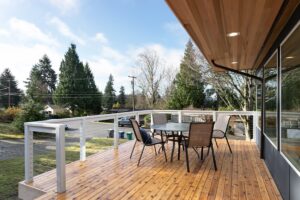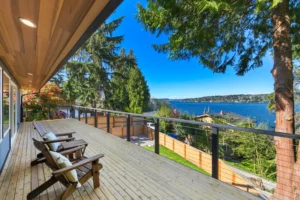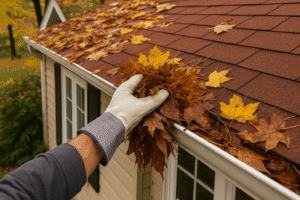In the Pacific Northwest, outdoor living is part of everyday life — and so is environmental responsibility. With lush landscapes, steady rainfall, and an eco-conscious community, many homeowners are rethinking traditional decking materials.
Old-growth wood decks are beautiful, but they can come with high maintenance demands and a heavy environmental footprint. Fortunately, new eco-friendly decking options allow you to enjoy a long-lasting, low-maintenance deck that’s both stylish and sustainable.
Whether you’re upgrading your existing deck or planning a new build, here’s a closer look at the best green decking materials for our region — and why they’re worth considering.
Curious how these sustainable materials compare in price? Explore our deck replacement cost guide for a detailed breakdown.
What Makes a Decking Material Eco-Friendly?
Not all “green” products are created equal. The sustainability of a decking material depends on several factors, including:
Source and renewability: Was it harvested responsibly or made from recycled materials?
- Manufacturing process: Does production minimize waste and emissions?
- Lifespan: Longer-lasting materials mean fewer replacements — and less waste.
- End-of-life recyclability: Can it be reused, recycled, or safely disposed of?
Pro Tip: In the Pacific Northwest, durability is sustainability. A deck that resists moisture, moss, and rot for decades helps prevent waste and replacement costs down the line.
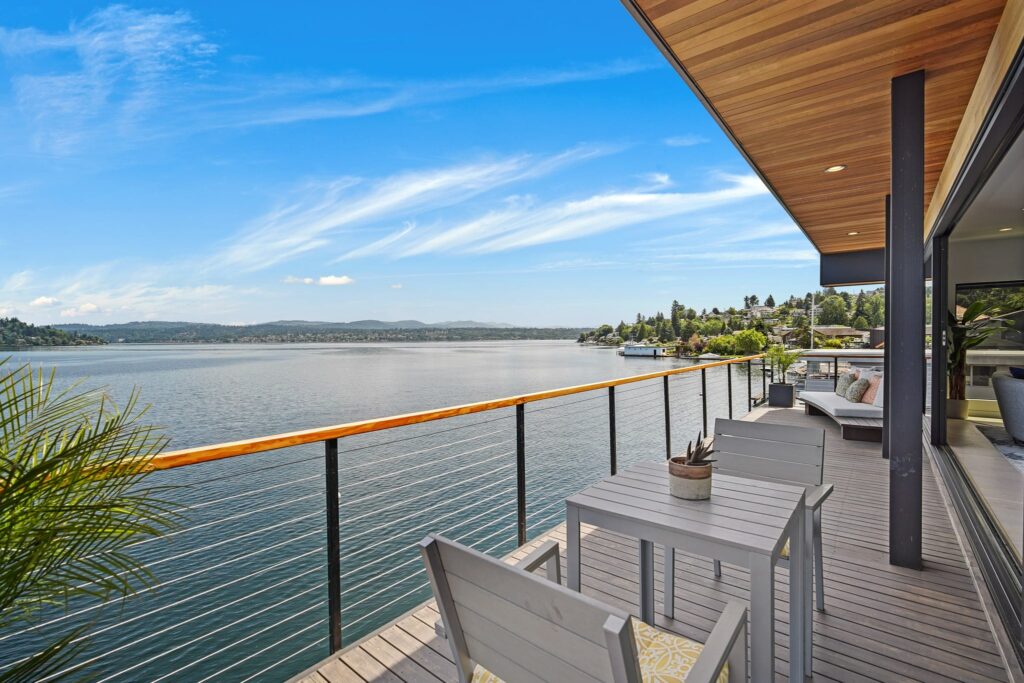
Sustainable Decking Materials That Work in the Pacific Northwest
1. Responsibly Sourced Cedar Decking
Cedar has long been a favorite in the Northwest — and when sourced from well-managed forests, it’s one of the most renewable materials available. It contains natural oils that resist insects and rot, making it ideal for our damp climate.
Pros: Natural look, renewable, biodegradable, locally available.
Cons: Requires consistent staining and sealing to prevent wear.
Best For: Homeowners who love the warmth and authenticity of natural wood and don’t mind occasional maintenance.
2. Recycled Composite Decking
Composite decking is one of the most popular sustainable materials today. It’s made from a blend of recycled wood fibers and plastic, offering the look of wood without the upkeep. Many composite brands now use up to 95% recycled content.
Pros: Long lifespan, minimal maintenance, resists rot and fading.
Cons: Non-biodegradable and energy-intensive to manufacture.
Best For: Homeowners who want a durable, low-maintenance deck that’s still environmentally conscious.
3. PVC Decking (Capped Polymer)
PVC decking is completely synthetic — no wood, no rot, no splinters. Because it’s made from recyclable polymer, it’s both durable and moisture-resistant, perfect for homes near water or under shade.
Pros: 100% recyclable, low maintenance, highly resistant to mold and mildew.
Cons: Higher upfront cost, but it lasts 30–50 years with minimal upkeep.
Best For: Waterfront homes and damp environments where traditional wood struggles to last.
4. Aspire Pavers by Brava
One of the most innovative eco-friendly products available today, Aspire Pavers are made from recycled rubber and plastics. They can be installed directly over existing surfaces, helping reduce demolition waste.
Pros: 95% recycled content, slip-resistant, highly durable, easy to maintain.
Cons: Premium pricing and limited availability compared to traditional decking.
Best For: Homeowners seeking a contemporary, sustainable deck surface with standout curb appeal.
5. Bamboo Decking (Thermally Treated)
Bamboo grows faster than any hardwood, making it one of the most renewable resources on earth. When properly heat-treated and compressed, it becomes a strong, stable, and eco-friendly decking alternative.
Pros: Rapidly renewable, absorbs CO₂ during growth, biodegradable.
Cons: Must be ethically sourced and sealed for moisture protection.
Best For: Eco-minded homeowners who want a sleek, modern look without the environmental impact of tropical hardwoods.
6. Recycled Porcelain or Concrete Pavers
For patios, rooftops, or modern decks, porcelain pavers offer exceptional sustainability. Many are made with recycled materials and last more than 50 years.
Pros: Recycled content, non-slip surface, extremely long lifespan.
Cons: Energy-intensive manufacturing and heavier shipping footprint.
Best For: Contemporary designs and low-maintenance outdoor spaces.
| Material | Recycled / Renewable | Maintenance | Lifespan | Moisture Resistance | Sustainability Rating |
|---|---|---|---|---|---|
| Cedar | Renewable | Moderate | 15–20 yrs | Medium | ★★★☆☆ |
| Composite | 95% recycled | Low | 25–30 yrs | High | ★★★★☆ |
| PVC | 100% recyclable | Very Low | 30–50 yrs | Very High | ★★★★★ |
| Aspire Pavers | 95% recycled | Very Low | 25+ yrs | Very High | ★★★★★ |
| Bamboo | Rapidly renewable | Moderate | 20–25 yrs | Medium | ★★★★☆ |
| Porcelain | Recycled | Very Low | 50+ yrs | High | ★★★★☆ |
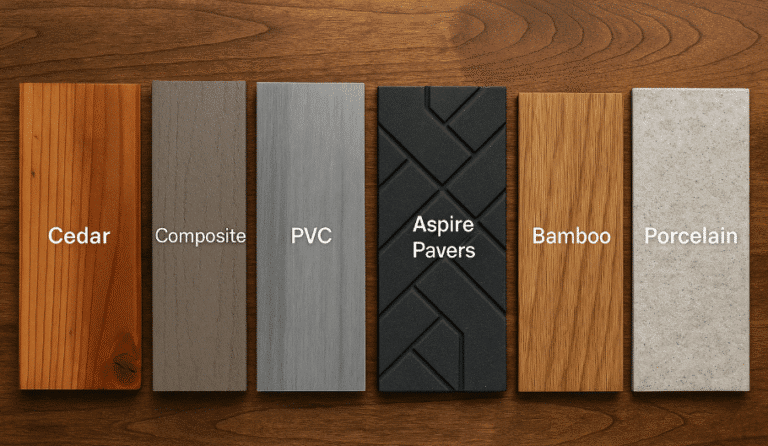
Beyond Materials: Building a Greener Deck
Sustainability extends beyond what your deck is made of — it’s also how it’s built and maintained.
Here are a few ways to make your project even more eco-friendly:
- Hire local contractors to reduce transportation emissions.
- Use FSC-certified framing lumber when wood is required.
- Add LED lighting for long-term energy savings.
- Design for drainage: Proper water management prevents rot and soil erosion.
- Incorporate native plants around your deck to support local wildlife and reduce water use.
Final Thoughts – Sustainability That Lasts
Choosing an eco-friendly decking material is about more than going green — it’s about building smarter and longer-lasting. In a region defined by evergreens and rain, the best decks are those that blend with the environment rather than work against it.
From recycled composites to Aspire Pavers by Brava, the Pacific Northwest offers plenty of sustainable choices that protect both your investment and the planet.
When you’re ready to upgrade, remember that the most eco-friendly deck is the one that lasts — and that starts with the right materials and professional installation.
Ready to take the next step? Learn how materials, size, and design impact your investment in our deck replacement cost guide
Frequently Asked Questions About Eco-Friendly Decking
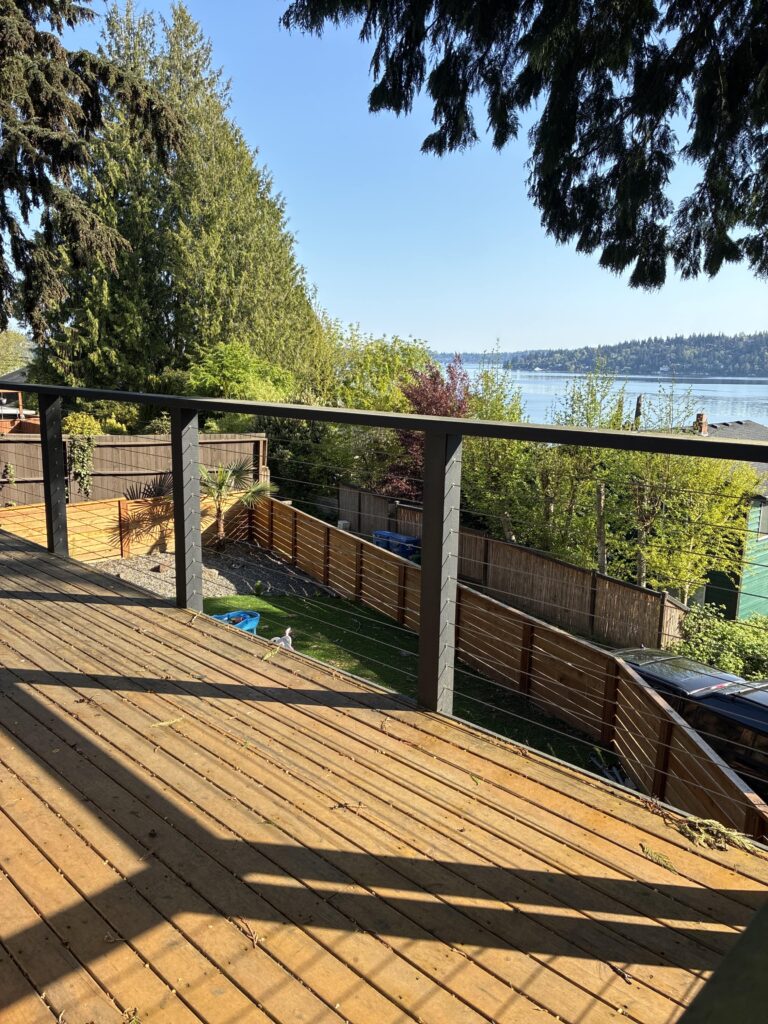
What is the most eco-friendly type of decking for the Pacific Northwest?
The best “green” choices here are the ones that last the longest with the least upkeep. Composite and PVC perform exceptionally well in our wet climate and often use high recycled content. Aspire Pavers by Brava (made from recycled rubber/plastics) are another standout. If you’re comparing sustainability with long-term budget, see typical price considerations in our deck replacement cost guide.
Are composite decks actually environmentally friendly?
Yes—quality composites are made from post-consumer plastics + recycled wood fibers and can last 25–30 years (or more), meaning fewer replacements and less waste. They also avoid repeated staining/sealing. For a practical look at how material choice affects your overall investment, check the ranges in our deck replacement cost guide
How do Aspire Pavers compare to traditional decking?
Aspire Pavers are manufactured with up to 95% recycled content and can often be installed over existing surfaces (reducing demo waste). They don’t warp or rot and are slip-resistant—great for damp PNW settings. If you’re weighing this upgrade against other materials, review budget impacts in our deck replacement cost guide.
What’s the difference between sustainable wood and composite decking?
Sustainably sourced cedar is renewable and biodegradable but needs routine sealing. Composite blends recycled plastics and wood fibers, trading frequent maintenance for longer service life. When deciding which route fits your home and wallet, compare lifetime ownership considerations with our deck replacement cost guide
How can I make my deck project more sustainable overall?
- Hire local contractors to cut transport emissions.
- Choose FSC-certified framing lumber where wood is required.
- Design proper drainage to protect soil and structure.
- Use LED lighting and native, low-water landscaping.
If a rebuild is on the table, align timing and budget using our deck replacement cost guide.
